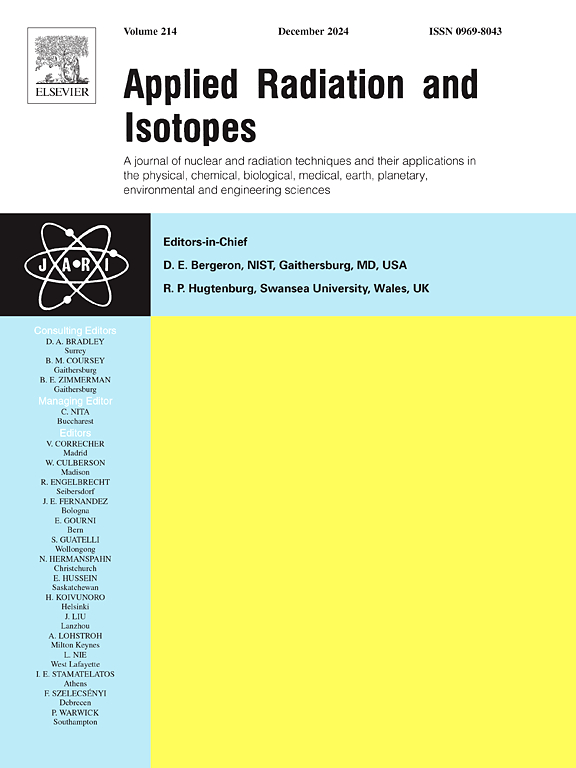在ISOLPHARM项目框架内简化细胞几何结构中银-111的蒙特卡罗剂量测定
IF 1.8
3区 工程技术
Q3 CHEMISTRY, INORGANIC & NUCLEAR
引用次数: 0
摘要
INFN的ISOLPHARM项目旨在研究111Ag β−发射器作为新型放射性药物的有前途的核心的性质。111Ag将在Legnaro国家实验室的spe设施中生产,具有高比活性和显著的产量,利用ISOL技术。这项工作提出了细胞水平的蒙特卡罗剂量法计算,以评估111Ag在ADMIRAL项目中的治疗潜力。利用MIRD引入的形式,计算了暴露于111Ag活性分布的不同情景下的生物细胞的s值。本文介绍并讨论了用Geant4、MCNP6和PHITS蒙特卡罗代码进行的剂量学计算结果,结果表明两者吻合良好,也与MIRDcell值吻合良好。这些结果将在ISOLPHARM项目中用于规划2D细胞培养和3D组织模拟支架的体外实验。本文章由计算机程序翻译,如有差异,请以英文原文为准。
Monte Carlo dosimetry of silver-111 in simplified cell geometries in the framework of the ISOLPHARM project
The ISOLPHARM project of the INFN aims to study the properties of the 111Ag emitter as a promising core for novel radiopharmaceuticals. 111Ag will be produced at the SPES facility of the Legnaro National Laboratories, with high specific activity and remarkable yields, exploiting the ISOL technique. This work presents Monte Carlo dosimetry calculations at cellular level to assess the therapeutic potential of 111Ag within the ADMIRAL project. Using the formalism introduced by the MIRD, S-values are calculated for a biological cell exposed to different scenarios of activity distributions of 111Ag. The results of dosimetry calculations performed with Geant4, MCNP6 and PHITS Monte Carlo codes are presented and discussed, showing a good mutual agreement and also with the MIRDcell values. These results will be used within the ISOLPHARM project for the planning of in-vitro experiments in 2D cell cultures and 3D tissue-mimicking scaffolds.
求助全文
通过发布文献求助,成功后即可免费获取论文全文。
去求助
来源期刊

Applied Radiation and Isotopes
工程技术-核科学技术
CiteScore
3.00
自引率
12.50%
发文量
406
审稿时长
13.5 months
期刊介绍:
Applied Radiation and Isotopes provides a high quality medium for the publication of substantial, original and scientific and technological papers on the development and peaceful application of nuclear, radiation and radionuclide techniques in chemistry, physics, biochemistry, biology, medicine, security, engineering and in the earth, planetary and environmental sciences, all including dosimetry. Nuclear techniques are defined in the broadest sense and both experimental and theoretical papers are welcome. They include the development and use of α- and β-particles, X-rays and γ-rays, neutrons and other nuclear particles and radiations from all sources, including radionuclides, synchrotron sources, cyclotrons and reactors and from the natural environment.
The journal aims to publish papers with significance to an international audience, containing substantial novelty and scientific impact. The Editors reserve the rights to reject, with or without external review, papers that do not meet these criteria.
Papers dealing with radiation processing, i.e., where radiation is used to bring about a biological, chemical or physical change in a material, should be directed to our sister journal Radiation Physics and Chemistry.
 求助内容:
求助内容: 应助结果提醒方式:
应助结果提醒方式:


